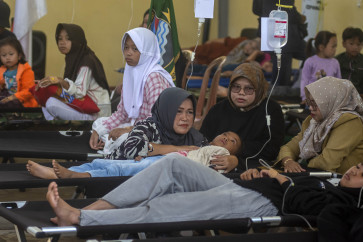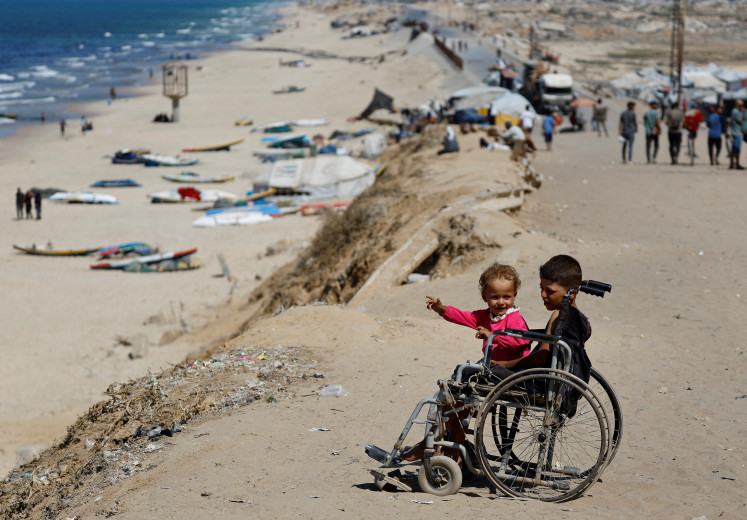Popular Reads
Top Results
Can't find what you're looking for?
View all search resultsPopular Reads
Top Results
Can't find what you're looking for?
View all search resultsTelling the tale of Minangkabau rituals
Cultural appreciation: Women in traditional dress study a photo of a married couple clad in traditional Minangkabau wedding attire at a Minangkabau Cultural exhibit in Jakarta
Change text size
Gift Premium Articles
to Anyone
C
span class="caption" style="width: 558px;">Cultural appreciation: Women in traditional dress study a photo of a married couple clad in traditional Minangkabau wedding attire at a Minangkabau Cultural exhibit in Jakarta. (JP/Ika Krismantari)
It’s hard not to mention rendang (slow-cooked beef) or songket (traditional woven cloth) when talking about West Sumatra’s cultural heritage.
But the province represents more than just a culinary delicacy or a piece of beautiful fabric, and an ongoing art exhibition confirms that by revealing the region’s rich ritual traditions practiced by its largest ethnic group, the Minangkabau.
Titled “Prosesi Minangkabau: Menyulam Keindahan Budaya Matrilinial” (Minangkabau Processions: Embroidering the Beauty of Matrilineal Culture), the exhibition explores Minangkabau traditions, which are both matrilineal and Muslim, through their lasting rituals.
The lives of the Minangkabau in the exhibition are depicted through wedding, funeral and religious ceremonies (Hoyak Tabuik), as well as the celebration of the investiture of cultural leaders and art performances (Alek Nagari Ulu Ambek).
The five most-celebrated processions are retold by the exhibition’s curator, Edy Utama, through photos, texts and displays of ornaments used in each ritual.
Edy, who is also an expert in West Sumatran culture, showcased the exhibition materials in Honolulu, Hawaii, earlier this year with the title “Minangkabau Processions of Sumatra”.
Yet Jakarta’s exhibition features additional displays of accessories and fabrics, including kris (dagger), jewelry and songket — usually worn during ceremonies — borrowed from collectors.
Edy said his latest exhibition aimed to introduce Minangkabau culture to not only the general public, but also to the Minang people themselves.
“Almost half of the Minang people reside outside [West Sumatra]. They were born and grew up here [in Jakarta]. They almost do not know about the existing traditions. This is an effort to reintroduce the culture to a changing generation,” he explained on the sidelines of the opening of the exhibition on Monday.
Presented at the Textile Museum in Tanah Abang, Central Jakarta, the opening ceremony offered a glimpse of wedding ceremonies, considered the pinnacle of Minangkabau culture.
A couple dressed in blue-and-red wedding attire were followed by a group bearing gifts and cone-shaped packages on their heads, all walking toward the exhibition room and opening the door as a symbol that the exhibition was officially open to the public.
Pictures of sadness: A set of photos depicts a Minangkabau funeral procession. (JP/Ika Krismantari)
At the entrance of the exhibition, visitors were greeted by displays of Minangkabau funeral processions, the show then proceeds to other rituals and concludes with a merry wedding stage.
Despite the unusual arrangement starting with death, all the cultural ceremonies and rituals depicted at Jakarta’s Textile Museum reflect the dynamic dialogue between traditional belief and Muslim values in the world’s largest matrilineal community.
People can also visit seven different rooms displaying a variety of heritage and cultural objects belonging to collectors.
The oldest piece of fabric is a 100-year-old curtain from the Miyara Sumatera Foundation established by businesswoman Irma Hutabarat, who is known for her passion for preserving Sumatra’s culture.
An antique bed with a colorful embroidered cover more than a century old is also on display from the collection of activist Mien Soedarpo.
Unfortunately, not all the objects are presented alongside written information, leaving visitors not in the know potential confused. This is perhaps due to the rush to prepare for the show, something organizing committee Yenni Santoso admitted in her opening speech.
A highlight was the songket exhibit, with replicas of more than 100-year-old weaving patterns. This revitalization is due to the hard work of Swiss couple Bernhard Bart and Erika Dubler and local artists Nina Rianti and Alda Wimar, who together established Studio Songket of ErikaRianti to explore and preserve the culture of Minangkabau cloth weaving.
“It is sad actually to see that this was done by foreigners. I believe it is a warning for us to continue preserving our cultural richness,” Edy said.
Aside from the exhibition, the organizers are also holding discussions and workshops on embroidery and batik painting with Minang-kabau patterns.
“We hope the program will provide sufficient information on the cloth tradition from the Minang-kabau,” museum head Indra Riawan said in a speech.
He also said he hopes that the exhibition will promote traditional Indonesian fabrics, especially from the Minangkabau, to the public.
In the end, it is not only about the cloth, but also the culture behind these beautiful fabrics.
“Prosesi Minangkabau: Menyulam Keindahan Budaya Matrilinial”Textile Museum
Jl. Aipda KS Tubun no. 2-4
from Nov. 12 to 18
9 a.m. until 3 p.m.

![Cultural appreciation: Women in traditional dress study a photo of a married couple clad in traditional Minangkabau wedding attire at a Minangkabau Cultural exhibit in Jakarta.(JP/Ika Krismantari)" border="0" height="420" width="560"><span class="caption" style="width: 558px;"><strong>Cultural appreciation: </strong>Women in traditional dress study a photo of a married couple clad in traditional Minangkabau wedding attire at a Minangkabau Cultural exhibit in Jakarta.<em><strong> (JP/Ika Krismantari)</strong></em></span></span></p><p>It’s hard not to mention rendang (slow-cooked beef) or songket (traditional woven cloth) when talking about West Sumatra’s cultural heritage.<br><br>But the province represents more than just a culinary delicacy or a piece of beautiful fabric, and an ongoing art exhibition confirms that by revealing the region’s rich ritual traditions practiced by its largest ethnic group, the Minangkabau.<br><br>Titled “Prosesi Minangkabau: Menyulam Keindahan Budaya Matrilinial” (Minangkabau Processions: Embroidering the Beauty of Matrilineal Culture), the exhibition explores Minangkabau traditions, which are both matrilineal and Muslim, through their lasting rituals.<br><br>The lives of the Minangkabau in the exhibition are depicted through wedding, funeral and religious ceremonies (Hoyak Tabuik), as well as the celebration of the investiture of cultural leaders and art performances (Alek Nagari Ulu Ambek).<br><br>The five most-celebrated processions are retold by the exhibition’s curator, Edy Utama, through photos, texts and displays of ornaments used in each ritual.<br><br>Edy, who is also an expert in West Sumatran culture, showcased the exhibition materials in Honolulu, Hawaii, earlier this year with the title “Minangkabau Processions of Sumatra”.<br><br>Yet Jakarta’s exhibition features additional displays of accessories and fabrics, including kris (dagger), jewelry and songket — usually worn during ceremonies — borrowed from collectors. <br><br>Edy said his latest exhibition aimed to introduce Minangkabau culture to not only the general public, but also to the Minang people themselves.<br><br>“Almost half of the Minang people reside outside [West Sumatra]. They were born and grew up here [in Jakarta]. They almost do not know about the existing traditions. This is an effort to reintroduce the culture to a changing generation,” he explained on the sidelines of the opening of the exhibition on Monday.<br><br>Presented at the Textile Museum in Tanah Abang, Central Jakarta, the opening ceremony offered a glimpse of wedding ceremonies, considered the pinnacle of Minangkabau culture.<br><br>A couple dressed in blue-and-red wedding attire were followed by a group bearing gifts and cone-shaped packages on their heads, all walking toward the exhibition room and opening the door as a symbol that the exhibition was officially open to the public.<br><span class="inline inline-none"><img class="image image-img_assist_custom-560x422 " src="http://www.thejakartapost.com/files/images2/p21-c_84.img_assist_custom-560x422.jpg" alt="Pictures of sadness: A set of photos depicts a Minangkabau funeral procession. (JP/Ika Krismantari)" title="Pictures of sadness: A set of photos depicts a Minangkabau funeral procession. (JP/Ika Krismantari)](https://www.thejakartapost.com/files/images2/p21-a_121.img_assist_custom-560x422.jpg)









